使用商业 WAM 监测肺癌患者。系统综述。
IF 4.5
2区 医学
Q1 ONCOLOGY
引用次数: 0
摘要
本系统性综述探讨了在肺癌治疗过程中使用商业活动监测器跟踪身体活动和健康相关结果的干预措施的可行性和影响。纳入标准主要是涉及向肺癌患者提供监测反馈的市售活动追踪器的研究。所选设备均为流行型号,包括 Fitbit、Garmin、Apple、Samsung 和 Polar。评估这些追踪器可靠性或有效性的研究,以及定性研究、协议、非英语出版物和使用非商业设备的研究均被排除在外。此外,将体育锻炼与其他干预措施(如机器人手术)相结合的研究,如果不能对锻炼结果进行独立分析,也排除在外。检索范围涵盖 2000 年 1 月至 2023 年 11 月期间的各种电子数据库,包括 Cochrane 系统综述数据库、CINAHL Complete®、科学引文索引、谷歌学术、Scopus、IEEE Xplore 和 PubMed。研究质量采用非随机干预研究偏倚风险(ROBINS-I)和随机试验偏倚风险(RoB 2.0)工具进行评估。有 12 项研究符合纳入标准,利用商业可穿戴技术对肺癌患者进行了平均 6.3 ± 4.7 周的监测。本综述的一个主要局限性是各研究的干预措施实施方式差异很大。然而,与常规护理相比,干预措施明显改善了日常活动水平和强度、生活质量、心理影响和身体功能。这些监测器在预测、监测和检测体力活动、激励患者和帮助康复方面显示出了前景。然而,这些监测器还存在局限性,需要进一步的证据来证实其作为肺癌治疗的主要监测工具的有效性。本文章由计算机程序翻译,如有差异,请以英文原文为准。
Use of commercial WAMs for monitoring individual with lung cancer. A systematic review
This systematic review explored the feasibility and impact of interventions using commercial activity monitors to track physical activity and health-related outcomes during lung cancer treatment. Inclusion criteria focused on studies involving commercially available activity trackers that provided monitoring feedback to lung cancer patients. The devices selected were popular models, including Fitbit, Garmin, Apple, Samsung, and Polar. Studies assessing the reliability or validity of these trackers, as well as qualitative studies, protocols, non-English publications, and those featuring non-commercial devices, were excluded. Additionally, studies incorporating physical activity with other interventions (e.g., robotic surgery) were excluded if exercise outcomes could not be analysed independently. Searches were conducted across various electronic databases, including the Cochrane Database of Systematic Reviews, CINAHL Complete®, Science Citation Index, Google Scholar, Scopus, IEEE Xplore, and PubMed, covering the period from January 2000 to November 2023. The quality of the studies was assessed using the Risk of Bias in Non-randomised Studies of Interventions (ROBINS-I) and the Risk of Bias in Randomised Trials (RoB 2.0) tools. Twelve studies met the inclusion criteria, utilising commercial wearable technology for monitoring lung cancer patients over an average of 6.3 ± 4.7 weeks. A key limitation of this review was the wide variation in how interventions were implemented across studies. Yet, the interventions significantly improved daily activity levels and intensity, quality of life, psychological impact, and physical function compared to usual care. These monitors show promise in predicting, monitoring, and detecting physical activity, motivating patients, and aiding in recovery. However, limitations exist, and further evidence is needed to confirm their efficacy as primary monitoring tools in lung cancer treatment.
求助全文
通过发布文献求助,成功后即可免费获取论文全文。
去求助
来源期刊

Lung Cancer
医学-呼吸系统
CiteScore
9.40
自引率
3.80%
发文量
407
审稿时长
25 days
期刊介绍:
Lung Cancer is an international publication covering the clinical, translational and basic science of malignancies of the lung and chest region.Original research articles, early reports, review articles, editorials and correspondence covering the prevention, epidemiology and etiology, basic biology, pathology, clinical assessment, surgery, chemotherapy, radiotherapy, combined treatment modalities, other treatment modalities and outcomes of lung cancer are welcome.
 求助内容:
求助内容: 应助结果提醒方式:
应助结果提醒方式:


